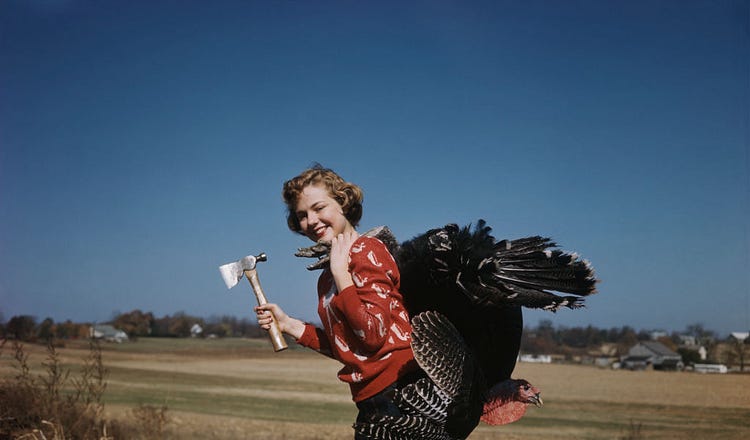
The man walking toward me was splattered with blood. His forearms were stained a pale magenta, his cheeks spattered with red flecks. The crumpled hide of a deer lay in a heap against the wall of the building behind him. Skinny hooved legs stuck out of 50-gallon oil drums nearby. It was like a scene out of a horror film.
But instead of brandishing a machete or a chain saw, the man with the bloodstained forearms carried a stubby pencil and a clipboard.
“Dropping off?” he asked.
It was the Saturday morning before Thanksgiving, several years ago, a sunny and chilly day. For the first time in my life, I was visiting a slaughterhouse—with my children, 9 and 13, in tow—and found that it was hopping. A line of trucks idled, everyone waiting their turn to drop off the birds they’d been raising for the last six months. A white-haired man with a weathered face and a worn-out cap leaned out of his Ford—stacked with several layers of crates holding white turkeys—and asked my daughter: “What did the turkey say to the chicken?”
She stared up at him for a second and then shrugged.
“Nothing,” he chuckled at her. “Turkeys can’t talk!”

My family was still new to farming, having moved to Greene County, New York, from Brooklyn only a few years earlier. Since then, my husband and I had just about learned how to kill and process chickens. But this was our first year raising turkeys, and we’d been overwhelmed at the thought of slaughtering 25-pound birds on our own. It wasn’t qualms about killing the turkeys; it was more whether we could do it without causing undue stress to the birds with our novice hands and backyard equipment.
When I first dreamed of moving upstate and raising our own animals for food, I wasn’t thinking about sharp knives and bloody hands; it was more about lambs dashing through clover-filled meadows and pots bubbling on the stove. The thing is, I love animals. I had tried to quit meat as a teenager, after my older sister made me read pamphlets about the horrific lives and deaths of factory-farmed creatures. Decades later, she’s still a vegetarian, but I could never abstain for long. That’s the other thing: I love meat, craving it so intensely that the sight of raw beef can set my mouth watering. So, for me, a workable alternative to quitting meat was to make sure that the animals I eat have been raised—and killed—well.
My friend Susie taught me how to slaughter birds.


